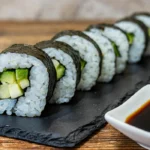
Introduction to Maki Sushi
The culinary landscape of Japan is a tapestry rich with tradition and innovation, where the delicate art of sushi holds a place of reverence. At the heart of this tradition lies maki maki sushi, a delightful expression of Japanese ingenuity in cuisine. The term “maki,” meaning “rolled,” refers to the intricate process of enveloping vinegared rice along with various fillings in nori (seaweed), presenting a harmonious blend of flavors and textures. Originating from the Nara period as a method of preserving fish in fermented rice, sushi has evolved considerably, with maki becoming a beloved variant across the globe.
Components
This recipe is distinguished by its components:
- Vinegared Rice: The soul of the sushi, its slightly sweet and tangy flavor is the perfect complement to the fillings.
- Nori: This seaweed wrapper not only holds the sushi together but adds a crisp, oceanic flavor.
- Fillings: From fresh fish like tuna and salmon to vegetables like cucumber and avocado, the fillings can vary widely.
- Condiments: Wasabi, soy sauce, and pickled ginger elevate the sushi experience with their distinct flavors.
Each element plays a vital role in creating the final dish, a testament to the balance and simplicity central to Japanese cuisine.
Discover more about crafting the perfect sushi rice through How to Cook Sushi Rice Like a Michelin Star Chef, a guide that dives deep into the art of sushi rice preparation.
Explore traditional and innovative recipes at Japan Centre’s Sushi Rolls Recipe and McCormick’s Top Sushi Recipes, where you can find a variety of rolls to try at home, from the classic California Roll to the inventive Dragon Roll.

Exploring Varieties and Techniques
Different Types
Maki maki sushi is celebrated for its variety, each type offering a unique taste and texture experience:
- Futomaki: These are the thick, robust rolls filled with multiple ingredients, including vegetables and sometimes fish, enveloped in a sheet of nori. They are a visual and culinary delight, often served during special occasions.
- Hosomaki: The simpler, thinner rolls, hosomaki feature a single filling, typically tuna, cucumber, or pickled radish, making them a minimalist’s choice.
- Chumaki: Medium in size, chumaki bridges the gap between hosomaki and futomaki, offering a balanced portion of rice and filling.
- Uramaki: Known as inside-out rolls, uramaki have rice on the outside and nori on the inside, often coated with sesame seeds or fish roe.
- Temaki: Hand-rolled into a cone shape, temaki are casual, fun, and easy to eat, filled with a variety of ingredients.
Maki Sushi Compared
The world of sushi is vast, with maki maki sushi being just one delicious part of it. It’s fascinating to compare maki with other sushi forms and Japanese dishes:
- Maki vs. Sushi: While “sushi” broadly refers to any dish made with vinegared rice, maki specifically denotes rolls. This distinction highlights maki’s unique preparation and presentation style.
- Maki vs. Sashimi: Sashimi, slices of raw fish without rice, offers a pure, unadulterated taste of the sea, contrasting with maki’s complex flavors and textures.
- Maki vs. Nigiri: Nigiri features slices of fish atop a mound of rice, focusing on the individual quality of each component, whereas maki combines several ingredients for a collective taste experience.
- Maki vs. Other Japanese Dishes: Comparing maki to dishes like tempura or ramen illuminates the diversity of Japanese cuisine, from the deep-fried delights of tempura to the rich, savory broth of ramen.
Preparation and Recipes

Tools and Techniques
The art of making this dish requires specific tools and techniques. A bamboo mat aids in tightly rolling the sushi, while a sharp knife ensures clean cuts. The process involves spreading vinegared rice on a sheet of nori, adding the fillings, and rolling it into shape. Precision and practice are key to creating perfect rolls.
Popular Maki Sushi Recipes
Several recipes have gained popularity worldwide, including:
- Boston Roll: A delightful combination of poached shrimp and creamy avocado.
- Dragon Roll: Features spicy tempura for a crunchy, flavorful experience.
- California Roll: A classic, with crab or surimi and avocado.
- Volcano Roll: Spicy tuna and shrimp bring heat to this roll.
- Rainbow Roll: Colorful and fresh, usually topped with an assortment of fish.
FAQs
Maki maki sushi enthusiasts often have questions about this beloved dish:
- Why is sushi called Maki? The term “maki” refers to the roll’s cylindrical shape, distinguished by its rolling technique.
- Is Maki sushi raw or cooked? Maki can be made with both raw and cooked ingredients, catering to a wide range of preferences.
- How often can I eat Maki sushi? While maki is healthy, moderation is key, especially with rolls containing raw fish.
- Can you lose weight with Maki sushi? Thanks to its high protein and omega-3 content, maki can be part of a balanced diet.
- Is Maki sushi considered a junk food or cheat meal? With its nutritious ingredients, maki is far from junk food and can fit into a healthy diet.
Nutritional and Health Aspects
The nutritional profile of this dish is influenced by its ingredients:
- Seafood offers lean protein and omega-3 fatty acids.
- Vegetables add vitamins, minerals, and fiber.
- Vinegared rice provides carbohydrates for energy. However, choices like mayo-based sauces or deep-fried tempura can increase calorie content.
Cultural and Global Influence
This dish has transcended its Japanese origins, becoming a global phenomenon. Its presence in international cuisine reflects a growing appreciation for Japanese culinary traditions, while innovations like the California roll demonstrate how different cultures adapt and embrace maki. This fusion of tastes and techniques speaks to the universal language of food and the shared human experience of communal dining.
As it continues to captivate palates worldwide, its story is one of cultural exchange, culinary innovation, and enduring appeal. From its humble beginnings to its status as a global favorite, maki embodies the spirit of Japanese cuisine: a celebration of simplicity, quality, and harmony.
For those keen to explore further, enrich your culinary journey with insights from Baked Salmon Sushi Recipe and complement your sushi experience with a side of Delicious Salmon Rolls: A Healthy Sushi Guide, highlighting the versatility and health benefits of incorporating seafood into your diet.

Explore Maki Maki Sushi: A Guide to Japanese Rolls
- Total Time: 20 minutes
- Yield: 8 pieces
Description
The culinary landscape of Japan is a tapestry rich with tradition and innovation, where the delicate art of sushi holds a place of reverence. At the heart of this tradition lies maki maki sushi, a delightful expression of Japanese ingenuity in cuisine. The term “maki,” meaning “rolled,” refers to the intricate process of enveloping vinegared rice along with various fillings in nori (seaweed), presenting a harmonious blend of flavors and textures. Originating from the Nara period as a method of preserving fish in fermented rice, sushi has evolved considerably, with maki becoming a beloved variant across the globe.
Ingredients
Sushi rice (vinegared rice)
Nori sheets (seaweed)
Cucumber, julienned
Soy sauce, for serving
Wasabi, for serving
Pickled ginger, for serving
Instructions
Cook sushi rice according to package instructions.
Once cooked, season with sushi vinegar (or a mix of rice vinegar, sugar, and salt) and allow to cool to room temperature.
Julienne the cucumber into thin strips, setting aside.
Place a bamboo sushi mat on your work surface.
Lay a sheet of nori, shiny side down, on the mat.
Wet your hands in the bowl of water (this prevents the rice from sticking to your hands).
Spread an even layer of sushi rice over the nori sheet, leaving about a half-inch of nori exposed at the top.
Lay the cucumber strips across the center of the rice.
Begin rolling from the bottom (nearest you), using the mat to firmly but gently compact the roll as you go.
Once rolled, use the mat to shape and firm up the roll. Ensure the exposed strip of nori seals the roll closed.
If the nori doesn’t seal, dab a little water on the edge to help it stick.
With a sharp, wet knife, cut the roll into 6-8 even pieces. Wetting the knife between cuts helps prevent sticking.
Arrange the sushi pieces on a plate.
Serve the maki sushi with soy sauce, wasabi, and pickled ginger on the side.
- Prep Time: 20 minutes
- Cook Time: 0 minutes
- Category: SEAFOOD
- Method: No Bake
- Cuisine: ASIAN
Nutrition
- Serving Size: 1 roll
- Calories: 300 calories
- Sugar: 3 grams
- Sodium: 750 mg
- Fat: 10 grams
- Saturated Fat: 2 grams
- Unsaturated Fat: 8 grams
- Trans Fat: 0 grams
- Carbohydrates: 40 grams
- Fiber: 4 grams
- Protein: 15 grams
- Cholesterol: 50 mg
Keywords: maki maki sushi, sushi rolls, Japanese sushi, makizushi, rolled sushi
